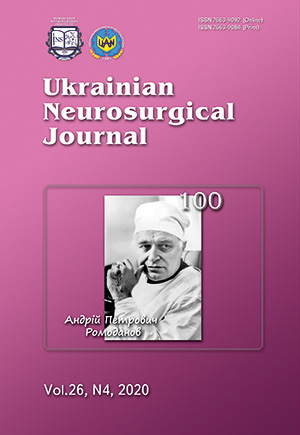Research of the functional activity of immunocompetent brain cells on separate occasions after experimental traumatic brain injury
DOI:
https://doi.org/10.25305/unj.205793Keywords:
brain injury, microglia, brain macrophages, phagocytosis, experimental studiesAbstract
Objective: To investigate the functional activity of microglia and monocytic/macrophage cells on separate occasions after the rat model of experimental brain injury.
Materials and methods. The rat model of experimental brain injury was simulated by dropping a load weighing 100 g from a height of 120 cm. Microglia and infiltrating CNS monocytes were isolated from rat brain tissue in a stepwise Percoll cushion. The activity of phagocytic brain cells was determined in the HCT test by the spectrophotometric method. Myeloperoxidase activity was determined in cell lysate by a quantitative spectrophotometric method.
Results. It was found that after brain injury there is an increase in the number of microglial / monocyte cells and an increase in spontaneous production of toxic oxygen molecules by these cells, which depends on the duration of injury and the location of the injury. The greatest threefold increase in microglial and monocytic/macrophage cells is determined on the 5th day after brain injury in the hemisphere with a traumatic injury. The maximum increase in spontaneous production of superoxide anion radical by these cells is also determined on the 5th day after brain injury. In contrast, myeloperoxidase activity of this cell population increases as early as 24 h after brain injury and gradually decreases to control values on the 10th day after the injury, which indicates the gradual development of the process.
Conclusion. The result of the researches demonstrated that on the 5th day after brain injury microglial and monocytic/macrophage M1 cells of pro-inflammatory phenotype prevail in the inflammation site. Influences on the cellular and molecular mechanisms that regulate the functional responses of microglia/macrophages after brain injury may facilitate the development of future therapeutic interventions aimed at the phenotypic transition of these cells from M1 to M2, which is necessary to improve CNS recovery.
References
1. Karve IP, Taylor JM, Crack PJ. The contribution of astrocytes and microglia to traumatic brain injury. Br J Pharmacol. 2016 Feb;173(4):692-702. [CrossRef] [PubMed] [PubMed Central]
2. Loane DJ, Kumar A. Microglia in the TBI brain: The good, the bad, and the dysregulated. Exp Neurol. 2016 Jan;275 Pt 3(0 3):316-327. [CrossRef] [PubMed] [PubMed Central]
3. Jassam YN, Izzy S, Whalen M, McGavern DB, El Khoury J. Neuroimmunology of Traumatic Brain Injury: Time for a Paradigm Shift. Neuron. 2017 Sep 13;95(6):1246-1265. [CrossRef] [PubMed] [PubMed Central]
4. Hsieh CL, Kim CC, Ryba BE, Niemi EC, Bando JK, Locksley RM, Liu J, Nakamura MC, Seaman WE. Traumatic brain injury induces macrophage subsets in the brain. Eur J Immunol. 2013 Aug;43(8):2010-22. [CrossRef] [PubMed] [PubMed Central]
5. Jin Y, Wang R, Yang S, Zhang X, Dai J. Role of Microglia Autophagy in Microglia Activation After Traumatic Brain Injury. World Neurosurg. 2017 Apr;100:351-360. [CrossRef] [PubMed]
6. Xu H, Wang Z, Li J, Wu H, Peng Y, Fan L, Chen J, Gu C, Yan F, Wang L, Chen G. The Polarization States of Microglia in TBI: A New Paradigm for Pharmacological Intervention. Neural Plast. 2017;2017:5405104. [CrossRef] [PubMed] [PubMed Central]
7. Gao HM, Liu B, Hong JS. Critical role for microglial NADPH oxidase in rotenone-induced degeneration of dopaminergic neurons. J Neurosci. 2003 Jul 16;23(15):6181-7. [CrossRef] [PubMed] [PubMed Central]
8. Sica A, Mantovani A. Macrophage plasticity and polarization: in vivo veritas. J Clin Invest. 2012 Mar;122(3):787-95. [CrossRef] [PubMed] [PubMed Central]
9. Jin Y, Wang R, Yang S, Zhang X, Dai J. Role of Microglia Autophagy in Microglia Activation After Traumatic Brain Injury. World Neurosurg. 2017 Apr;100:351-360. [CrossRef] [PubMed]
10. Sedgwick JD, Schwender S, Imrich H, Dörries R, Butcher GW, ter Meulen V. Isolation and direct characterization of resident microglial cells from the normal and inflamed central nervous system. Proc Natl Acad Sci U S A. 1991 Aug 15;88(16):7438-42. [CrossRef] [PubMed] [PubMed Central]
11. Lisyanyy MI, Belska LM, Semenova VM, Rozumenko VD, Stajno LP. [Study of effect of rat embryonic neural tissue peptides on intracerebral tumor cells and functional activity of peripheral blood mononuclears]. Problems of Cryobiology and Cryomedicine. 2008 Dec 22;18(4):441-444. Ukrainian. http://cryo.org.ua/journal/index.php/probl-cryobiol-cryomed/article/view/347
12. Rudenko VA, Gnedkova IO, Pichkur LD, Verbovska SA, Pokholenko YaO. [Influence of xenogenic transplantation of mesenchymal stem cells and Il- 10 on cellular immunity in rats with experimental allergic encephalomyelitis]. Coliection of Scientific Works of Staff Member of P. L. Shupyk NMAPE. 2014;(23(2)):434-41. Ukrainian. http://nbuv.gov.ua/UJRN/Znpsnmapo_2014_23%282%29__59
13. Colton CA, Gilbert DL. Production of superoxide anions by a CNS macrophage, the microglia. FEBS Lett. 1987 Nov 2;223(2):284-8. [CrossRef] [PubMed]
14. Woodroofe MN, Hayes GM, Cuzner ML. Fc receptor density, MHC antigen expression and superoxide production are increased in interferon-gamma-treated microglia isolated from adult rat brain. Immunology. 1989 Nov;68(3):421-6. [PubMed] [PubMed Central]
Downloads
Published
How to Cite
Issue
Section
License
Copyright (c) 2020 Mykola I. Lisianyi, Lyudmyla M. Belska

This work is licensed under a Creative Commons Attribution 4.0 International License.
Ukrainian Neurosurgical Journal abides by the CREATIVE COMMONS copyright rights and permissions for open access journals.
Authors, who are published in this Journal, agree to the following conditions:
1. The authors reserve the right to authorship of the work and pass the first publication right of this work to the Journal under the terms of Creative Commons Attribution License, which allows others to freely distribute the published research with the obligatory reference to the authors of the original work and the first publication of the work in this Journal.
2. The authors have the right to conclude separate supplement agreements that relate to non-exclusive work distribution in the form of which it has been published by the Journal (for example, to upload the work to the online storage of the Journal or publish it as part of a monograph), provided that the reference to the first publication of the work in this Journal is included.









